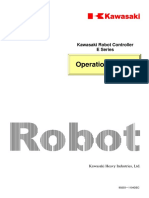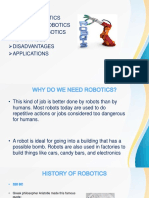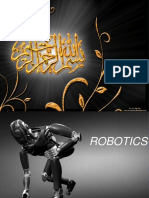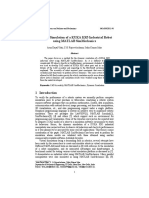Professional Documents
Culture Documents
Development of Low Grade Robotic Arm For Small Industries
Original Title
Copyright
Available Formats
Share this document
Did you find this document useful?
Is this content inappropriate?
Report this DocumentCopyright:
Available Formats
Development of Low Grade Robotic Arm For Small Industries
Copyright:
Available Formats
Volume 4, Issue 9, September – 2019 International Journal of Innovative Science and Research Technology
ISSN No:-2456-2165
Development of Low Grade Robotic Arm for
Small Industries
Izuwa Emmanuel
Abstract:- This paper focused on the development of low Robotic arms have been around for a long time, they are
grade robotic arm for small industries who cannot afford used in industries for tasks such as welding, assembly lines,
heavy duty and expensive arm made by most companies. material handling etc. and they serve their purpose effectively.
Most small factories in regions like Africa are in desperate As pointed out in the study of [3], the use of the industrial
need of a device to handle repetitive tasks but they cannot robot, which became identifiable as a unique device in the
meet up with the purchase and maintenance cost of 1960s along with computer-aided design (CAD) systems and
companies like KUKA, Fanuc, etc. so they rely on human computer-aided manufacturing (CAM) systems, characterizes
labour which is inaccurate and causes body pain for the the latest trends in the automation of the manufacturing
workers. In this work, a 5 degree of freedom robotic arm process.
was developed to solve this problem.
The idea to use multiple end effectors have been around
The link of the robotic arm was 3d printed using poly for some years now. A specific arm can be well equipped and
lactic acid filaments and the ATmega328P AVR designed with all types of end effectors which are fitted for
microcontroller was used to control the arm, four metal particular application. [4].
gear servo was used to actuate the arm while one servo was
used for the end effector. The critical load for the arm was In this paper, a 5 degree of freedom robotic arm was
established after running the stress analysis for each of the developed. These type of robots are used in factories for
links. And forward and inverse kinematic equations was tedious repetitive tasks that leads to body pain and
developed to track the position and rotation of the end deformation when performed by a human.
effector in 3D space. The arm can work in two modes,
sentry and user mode. A hard switch was provided to The design process taken include design stage,
switch from one mode to the other. Sentry mode was construction and testing. The mechanical and electrical design
designed for repetitive tasks. User mode allows a controller of the arm allows for different end effectors to be attached to
to operate the arm using a joystick to control the joints. perform various tasks. The robot was actuated using two types
Software stress analysis was done using Autodesk inventor of servo motors, the MG996r metal gear servo and the SG90
and physical evaluations were conducted and the arm 9g servo. The ATmega328P was used as the Micro control
performed as expected. unit(MCU) and it was powered using rechargeable batteries.
The links of the robotic arm 3D printed using Poly lactic acid
Keywords:- Robotic Arm, Industrial Robot, Robotics, Forward (PLA) and other materials such as wood and aluminium were
Kinematics, Inverse Kinematics, Automation. employed to complete the build. The arm has a base which
rotates 180 degrees around the z-axes and two links joined by
I. INTRODUCTION a rotary joint. Only one end effector was used in the test but
others can be attached depending on the task at hand.
A robot is an electro-mechanical machine, which is
guided by a computer program or electronic circuitry to carry II. MATERIALS AND METHODS
out a variety of physical tasks or actions. There have been
many definitions of a robot. According to[1] a robot arm is a The procedures employed include the design stage,
device which is to do performs automated task, either construction and testing. To track the position of the end
according to direct human supervision, pre-defined program, effector in 3D-space, it was necessary to device kinematic
set of general guideline, using (artificial intelligence) equations to do this.
techniques.
2.1 Forward Kinematic Analysis
Robots have found their way into most aspects of life To get the position of the end effector after rotating the
such as from manufacturing to our various homes. In the past joints, a forward kinematics equation was derived. Joint
few decades the robotic arm industry has experienced rotations were gotten by reading the initial and final position
exponential growth, this has made it possible for vast research of the servo motors. This angles were then injected into a
and development to occur [2]. forward kinematics equation which was used to know both the
position and rotation of the tool center position(TCP).
IJISRT19SEP1192 www.ijisrt.com 794
Volume 4, Issue 9, September – 2019 International Journal of Innovative Science and Research Technology
ISSN No:-2456-2165
Where subscripts x, y and z are the axes around which the
Figure 2.0 and table 2.0 shows translations revealed by rotation occurs, and 𝜃 is the angle of rotation.
Geometric analysis of the robotic arm.
A homogenous transformation matrix ‘T’ was created by
combining both rotation and translation.
𝑅 ∆]
𝑇= [ (4)
0 1
Where;
𝑅11 𝑅12 𝑅13
R = rotation matrix =𝑅21 𝑅22 𝑅23 (5)
𝑅31 𝑅32 𝑅33
And
∆𝑥
FIGURE 2.0 Translation = ∆ = {∆𝑦 (6)
JOINTS IN THE ROBOTIC ARM
∆𝑧
TABLE I Hence,
az1 ax2 ay2 az2 az3 ay3 ax4 ay4 𝑅11 𝑅12 𝑅13 ∆𝑥
59 11 15.5 21 90 10 100 9.5 𝑅 𝑅22 𝑅23 ∆𝑦
𝑇 = [ 21 ] [ ] (7)
TRANSLATIONS ON THE ROBOTIC ARM 𝑅31 𝑅32 𝑅33 ∆𝑧
0 0 0 1
Where az1 is the translation along the z axis between the base
and joint 1 𝑅11 𝑅12 𝑅13 ∆𝑥
ax2 is the translation along the x axis between the joint1 and 𝑅 𝑅22 𝑅23 ∆𝑦
𝑇 = [ 21 ] (8)
joint2 𝑅31 𝑅32 𝑅33 ∆𝑧
ay2 is the translation along the y axis between the joint1 and 0 0 0 1
joint2
az2 is the translation along the z axis between the joint1 and The combined rotation and translation matrix was gotten by
joint2 moving from joint to joint.
ax3 is the translation along the x axis between the joint2 and
joint3 From the base to joint 1(J1), translation only occurs in the z-
az3 is the translation along the z axis between the joint2 and axes and rotation is around the z-axes. The translation is
joint3 denoted by az1. The matrix is shown in (9) and (10).
ay3 is the translation along the y axis between the joint2 and
joint3 cos 𝜃1 − sin 𝜃1 0 0
ax4 is the translation along the x axis between the joint3 and sin 𝜃1 cos 𝜃1 0 0 ]
𝑇1 = [ (9)
joint4 0 0 1 𝑎𝑧1
ay4 is the translation along the y axis between the joint3 and 0 0 0 1
joint4
cos 𝜃1 − sin 𝜃1 0 0
Combined rotation and translation was considered and the
sin 𝜃1 cos 𝜃1 0 0]
base of the arm served as the local coordinate system. Rotation 𝑇1 = [ (10)
matrix around each axes is given by (1), (2) and (3); 0 0 1 59
0 0 0 1
1 0 0
𝑅𝑥 (𝜃) = 0 cos 𝜃 − sin 𝜃 (1) From J1 to J2, translation occurs in all 3 axes and rotation is
around the y-axes. The translations are denoted by ax2, az2,
0 sin 𝜃 cos 𝜃
ay2. The matrix is shown in (11).
cos 𝜃 0 sin 𝜃
𝑅𝑦 (𝜃) = 0 1 0 (2) cos 𝜃2 0 𝑠𝑖𝑛 𝜃2 11
− sin 𝜃 0 cos 𝜃 𝑇2 = [ 0 1 0 15.5] (11)
−𝑠𝑖𝑛 𝜃2 0 cos 𝜃2 21
cos 𝜃 − sin 𝜃 0 0 0 0 1
𝑅𝑧 (𝜃) = sin 𝜃 cos 𝜃 0(3)
0 0 1 From J2 to J3, translation occurs in 3 axes and rotation is
around the y-axes. The translations are denoted by az3, ay3.
The matrix is shown in (12).
IJISRT19SEP1192 www.ijisrt.com 795
Volume 4, Issue 9, September – 2019 International Journal of Innovative Science and Research Technology
ISSN No:-2456-2165
cos 𝜃3 0 𝑠𝑖𝑛 𝜃3 0
𝑇3 = [ 0 1 0 10] (12)
−𝑠𝑖𝑛 𝜃3 0 cos 𝜃3 90
0 0 0 1
From J3 to J4, translation occurs in the x and y axes and
rotation is around the y-axes. The translations are denoted by
ax4, az4. The matrix is shown in (13).
cos 𝜃4 0 𝑠𝑖𝑛 𝜃4 100
FIGURE 2.1
𝑇4 = [ 0 1 0 9.5 ] (13) FREE BODY DIAGRAM OF THE ARM
−𝑠𝑖𝑛 𝜃4 0 cos 𝜃4 0
0 0 0 1
2.3 Stress Analysis of Links
Deformation could only be prevented by not overloading
The combined rotation matrix for the arm is gotten by the robotic arm, so it was necessary to determine the
evaluating 𝑇𝑐 maximum load the arm could lift. The following design
𝑇𝑐 = 𝑇1 ∗ 𝑇2 ∗ 𝑇3 ∗ 𝑇4 (14) assumptions guided the design process;
It was assumed that all bolted joints are completely rigid.
It was assumed that the material for the linkages obey
𝑋 hooks law
End effector position = 𝑇𝑐 ∗ [𝑌 ] (15) Maximum permissible slope throughout the arm was 0.50
𝑍 (0.0087 radian)
1 Maximum allowable deflection in the arm was 0.5mm
Where [X, Y, Z] defines the position of the base
2.3.1 Link (3) (stress analysis)
(16) was used to predict the position of the end effector.
It was necessary to obtain the centroid of link3 because
that’s where the self weight of the arm acts. Figure 2.2 was
2.2 Inverse Kinematics Analysis
used to obtain the centroid.
The inverse kinematic equation was used to get the angle of
rotation in each joint needed to get to a desired position with
the end effector. To get to a position X, Y, Z with the end
effector, the required joint angles for joint 1, 2 and 3 was
gotten using (16), (17) and (18).
𝐽3
= 180
𝑎𝑧32 + (𝑎𝑧3 + 𝑎𝑥4)2 − 𝑋 2 − 𝑍 2 FIGURE 2.2
− 𝑎𝑟𝑐𝐶𝑜𝑠 ( ) (16) LINK 3 (SECTIONING)
2 ∗ (𝑎𝑧3 + 𝑎𝑥4) ∗ 𝑎𝑧3
𝐽2 𝐴1 𝑋1 = 900 𝑋 15 = 13500𝑚𝑚3
𝑍
= 𝑎𝑟𝑐𝑇𝑎𝑛 ( ) 𝐴2 𝑥2 = 135 𝑥 87.5 = 11812.5𝑐𝑚3
𝑋 𝐴3 𝑥3 = 135 𝑥 87.5 = 11812.5𝑚𝑚3
𝑎𝑧32 − (𝑎𝑧3 + 𝑎𝑥4)2 + 𝑋 2 + 𝑍 2
+ 𝑎𝑟𝑐𝐶𝑜𝑠 ( ) (17) 𝐴4 𝑥 𝑥4 = 52.5 𝑥 73.75 = 3871.875𝑚𝑚3
2 ∗ 𝑎𝑧3 ∗ √𝑋 2 + 𝑌 2 𝐴5 𝑥5 = 268 𝑥 119.5 = 32026𝑚𝑚3
𝑌 𝐴6 𝑥6 = 490 𝑥 475 = 23275𝑚𝑚3
𝐽1 = 𝑎𝑟𝑐𝑇𝑎𝑛 ( ) (18) 𝐴1 𝑋1 + 𝐴2𝑋2 + 𝐴3 𝑋3 + 𝐴4 𝑋4 + 𝐴5 𝑋5 + 𝐴6 𝑋6
𝑋 𝑋 = 𝐴1 + 𝐴2 + 𝐴3 + 𝐴4+ 𝐴5 + 𝐴6
96297.875
Where J1 is the angle for joint 1 𝑋 = = 48.62𝑚𝑚
1980.5
J2 is the angle for joint 2,
J3 is the angle for joint 3, The load (P) lifted by the arm acted at the tip of the end
X is the desired position in the x axis effector. The load diagram and free body diagram is shown in
Y is the desired position in the y axis Figure 2.3 and Figure 2.4 respectively
Z is the desired position in the x axis
Figure 2.1 Shows the free body diagram of the arm.
IJISRT19SEP1192 www.ijisrt.com 796
Volume 4, Issue 9, September – 2019 International Journal of Innovative Science and Research Technology
ISSN No:-2456-2165
To analyse the effect of deformations on the link, the free
body diagram (FBD) in Newton is shown in Figure 2.5.
FIGURE 2.3
LOAD DIAGRAM FOR LINK 3
FIGURE 2.5
FREE BODY DIAGRAM IN NEWTON (LINK 3)
Bending moment equation using Macaulay principle. [6]
was derived as shown in (23);
FIGURE 2.4 𝑀𝑥 = 𝑅𝐴 𝑥 – 𝑀𝐴 − 0.4 〈𝑥 − 33.6〉
FREE BODY DIAGRAM FOR LINK 3 − 0.14〈 𝑥 − 68.6〉 (23)
Equilibrium condition. Summation of vertical forces must be reaction at A is gotten from (19)
equal to zero; 𝑅𝐴 = 0.4 + 0.14 + 𝑃
𝑅𝐴 = 40.4 + 14 + 𝑃 𝑅𝐴 = (0.54 + 𝑃) 𝑁
𝑅𝐴 = (54.4 + 𝑃)𝑔 (∑𝑓𝑣 = 0) (19) 𝑀𝐴 = (23.044 + 129.6𝑃)𝑁𝑚𝑚
Equilibrium condition. Summation of horizontal forces must From Euler’s equation. [6]
be equal to zero; 𝐸𝐼𝑑2 𝑦
= − 𝑀𝑥 (24)
𝐻𝐴 = 0 (∑𝐹𝐻 = 0) (20) 𝑑𝑥 2
Summing moments about point A yielded (21).
𝑀𝐴 = (2317.84 + 129.6𝑃)𝑔𝑚𝑚 (∑𝑀 = 0) (21) Where𝐸 is the elastic modulus of the material in use
𝐼 is the moment of inertia of the cross-section about the
The moment 𝑀𝐴opposed the torque produced by the actuator. bending axis
So it was necessary the actuator could produce enough torque 𝑦 is the deflection along the beam
to overcome this moment. The MG996r metal gear servo 𝑥 is any point of interest along the beam
produced a maximum stall torque (𝑇𝑆 ) of 11kgcm. [5] While 𝑀𝑥 is the bending moment.
Stall torque (𝑇𝑆 ) = 11 x 1000 x 10gmm (converting to gram Double integration of (23) yields (25) and (26) which are slope
millimeter) and deflection equation respectively.
𝐸𝐼𝑦” = − 𝑀𝑥
𝑇𝑆 = 110000𝑔𝑚𝑚 𝐸𝐼𝑦” = 𝑀𝐴 + 0.4 〈𝑥 − 33.6〉 + 0.14 〈𝑥 − 68.6 〉 − 𝑅𝐴 𝑥
𝐸𝐼𝑦 ′
Performance factor (𝐹𝑝 ) was introduced to compensate for any = 𝑀𝐴 𝑥 + 0.2 〈𝑥 − 33.6〉2 + 0.07 〈𝑥 − 68.6〉2
flaws in the servo motor. − 0.5 𝑅𝐴 𝑥 2 + 𝐶1 (25)
𝐹𝑝 = 0.8 𝐸𝐼𝑦 = 0.5𝑀𝐴 𝑥 2 + 0.0667〈 𝑥 − 33.6〉3
𝑇′𝑆 = 𝑇𝑠 𝑥 𝐹𝑝 + 0.0233〈𝑥 − 68.6〉3 − 0.1667𝑅𝐴 𝑥 3
+ 𝐶1𝑥 + 𝐶2 (26)
𝑇′𝑆 = 110000 𝑥 0.8
Boundary Condition
𝑇′𝑆 = 88000𝑔𝑚𝑚
𝐷𝑒𝑓𝑙𝑒𝑐𝑡𝑖𝑜𝑛 𝑎𝑡 𝑝𝑜𝑖𝑛𝑡 𝐴 (𝑥 = 0) = 0 (𝑎)
Equilibrium condition is shown in (22). 𝑆𝑙𝑜𝑝𝑒 𝑎𝑡 𝑝𝑜𝑖𝑛𝑡 𝐴 (𝑥 = 0) = 0 (𝑏)
𝑇𝑜𝑟𝑞𝑢𝑒 𝑝𝑟𝑜𝑑𝑢𝑐𝑒𝑑 𝑏𝑦 𝑠𝑒𝑟𝑣𝑜 𝑀𝑜𝑡𝑜𝑟 = 𝑀𝐴 (22)
Applying condition (a) to (25);
From (19) and (21);
𝐸1(0) = 0.5𝑀𝐴 (0)2 – 0.1667𝑅𝐴 (0)3 + 𝐶1(0) + 𝐶2
88000 = 2317.84 + 129.6𝑃
88000 – 2317.84 𝐶2 = 0
𝑃= (𝑔𝑚𝑚)
129.6mm Applying condition (b) to (24);
𝑷 = 𝟔𝟔𝟏. 𝟏𝟑𝒈
𝐸1(0) = 𝑀𝐴 (0) – 0.5𝑅𝐴 (0)2 + 𝐶1
For the actuator to effectively lift the load. P must not exceed 𝐶1 = 0
660g.
IJISRT19SEP1192 www.ijisrt.com 797
Volume 4, Issue 9, September – 2019 International Journal of Innovative Science and Research Technology
ISSN No:-2456-2165
Haven obtained the value of the integration constants, From design assumptions, 𝜃𝐿 = 0.00873 𝑟𝑎𝑑𝑖𝑎𝑛
deflection and slope equations are written in (27) and (28) 2.24 𝑥 106 𝑥 0.00873 = 555.2 + 8393.1𝑃
respectively; 8393.1𝑃 = 19000
Slope equation 𝑃 = 2.264𝑁
𝐸1𝜃 = 𝑀𝐴 𝑥 + 0.2 〈𝑥 − 33.6〉2 + 0.07〈 𝑥 − 68.6〉2 𝑷 = 𝟐𝟐𝟔. 𝟑𝟖𝒈
− 0.5 𝑅𝐴 𝑥 2 (27) Hence, if the maximum allowable slope in link 3 is to be
limited to 0.5 degrees, the load must not exceed 225g.
Deflection equation
𝐸1𝑦 = 0.5𝑀𝐴 𝑥 2 + 0.0667 〈𝑥 − 33.6〉3 Substituting L = 129.6mm into (28) gave (33);
+ 0.0233〈 𝑥 − 68.6〉3 𝐸1𝑦 = 0.5𝑀𝐴 (129.6)2 + 0.0667 (129.6 – 33.6)3
− 0.16667 𝑅𝐴 𝑥 3 (28) + 0.0233(129.6 − 68.6)3
− 0.1667𝑅𝐴 (129.6)3 (33)
In-depth analysis of (27) and (28) revealed that slope and 𝐸1𝑦 = 64300.55 + 8398.1𝑀𝐴 – 362804.3𝑅𝐴 (34)
deflection are maximum the end of the beam. i.e. at point L.
𝑊ℎ𝑒𝑟𝑒 𝐿 𝑖𝑠 𝑡ℎ𝑒 𝑡𝑜𝑡𝑎𝑙 𝑙𝑒𝑛𝑔𝑡ℎ 𝑜𝑓 𝑡ℎ𝑒 𝑙𝑖𝑛𝑘 Ra and Ma was substituted into (34) to form (35) as shown
In this case 𝐿 = 129.6𝑚𝑚 below;
𝐸1𝑦 = 64300.55
Elastic modules for Poly Lactic Acid is 3.5Gpa. [7]. + 8398.1 (23.044
𝐸 = 3.5 𝑥 109 𝑁/𝑚2 + 129.6𝑃)– 362804.3 (0.54
𝑁 + 𝑃) (35)
𝐸 = 3.5 𝑥109 6 𝑚𝑚2
10
𝐸 = 3.5 𝑥 103 𝑁/𝑚𝑚2 I and E are already known and y is known from the design
assumptions as 0.5mm. hence the value of P was gotten as
Moment of inertia for minimum cross section is gotten from shown below;
Figure 2.6 as shown below; (1.12 𝑥 106 ) – 61912.048
𝑃=
725589.46
𝑃 = 1.458𝑁
𝑷 = 𝟏𝟒𝟓. 𝟖𝟐𝒈
The maximum allowable load given by the actuator is 660g.
And that for slope and deflection was 225g and 145g
respectively. We will choose the lowest value obtained. So for
link (3) not to fail under loading, the maximum value of P was
taken as 145𝑔.
2.3.2 Link (2) (stress Analysis)
FIGURE 2.6 The centroid of link 2 is obtained from Figure2.7 as shown
CROSS SECTION FOR LINK 3 below;
𝑏𝑑 3 15 (8)3
𝐼𝑥𝑥 = = = 640𝑚𝑚4
12 12
𝑁
𝐸𝐼 = 3.5 𝑥 103 𝑥 640 ( 𝑥 𝑚𝑚4 )
𝑚𝑚2
𝐸𝐼 = 2.24 𝑥 106 𝑁𝑚𝑚2
Substituting L into (27) gave (29)
𝐸𝐼𝜃𝐿 FIGURE 2.7
= 𝑀𝐴 (129.6) + 0.2 (129.6 – 33.6)2 LINK 2 (SECTIONING)
+ 0.07 (129.6 – 68.6)2 – 0.5𝑅𝐴 (029.6)2 (29)
𝐸𝐼𝜃𝐿 = 129.6𝑀𝐴 + 2103.67 – 8398.1𝑅𝐴 (30) 𝐴1 𝑋1 = 307.9 ∗ 8 = 2463.2𝑚𝑚3
𝑅𝐴 and𝑀𝐴 was substituted into (29) to give (30) as shown 𝐴2𝑋2 = 1620 ∗ 34.5 = 55890𝑚𝑚3
below; 𝐴3 𝑋3 = 660 ∗ 68 = 44880𝑚𝑚3
𝐸𝐼𝜃𝐿 = 129.6 (23.04 + 129.6𝑃) 𝐴4 𝑋4 = 1620 ∗ 101.5 = 164430𝑚𝑚3
+ 2103.67 – 8398.1 (0.54 + 𝑃) (31) 𝐴6 𝑋6 = 307.9 ∗ 128 = 39411.2𝑚𝑚3
𝐸𝐼𝜃𝐿 = 555.2 + 8393.1𝑃 (32) ∑𝐴𝑋 403212.4 307074.4
𝑋 = = =
∑𝐴 5397.8 4515.8
IJISRT19SEP1192 www.ijisrt.com 798
Volume 4, Issue 9, September – 2019 International Journal of Innovative Science and Research Technology
ISSN No:-2456-2165
𝑋 = 68𝑚𝑚 𝑇𝑜𝑟𝑞𝑢𝑒 𝑝𝑟𝑜𝑑𝑢𝑐𝑒𝑑 𝑏𝑦 𝑠𝑒𝑟𝑣𝑜 𝑀𝑜𝑡𝑜𝑟 = 𝑀𝑄 (42)
8800 = 𝑇’𝑠 = 14021.64 + 211.6𝑃
The load diagram and free body diagram is shown in Figure 88000 − 14021.64
2.8 and Figure2.9 respectively; 𝑃 =
211.6
𝑷 = 𝟑𝟒𝟗. 𝟔𝒈
For the actuator to function effectively. P must not exceed
349g.
Bending moment equation using Macaulay principle.
was derived as shown in (43)
FIGURE 2.8 𝑀𝑥 = 𝑅𝑄 𝑥 – 0.55 〈𝑥 − 11〉 – 0.38〈 𝑥 − 56〉 – 0.55 〈𝑥
LOAD DIAGRAM FOR LINK 2 − 82〉 – 0.404〈 𝑥 − 115.6〉 – 𝑀𝑄
− 0.14〈 𝑥 − 50.6〉 (43)
Applying Euler’s equation.
𝐸1𝑦 " = – 𝑀𝑥 (44)
𝐸1𝑦 "
= 0.55 〈𝑥 − 11〉 + 0.38 〈𝑥 − 56〉 + 0.55 〈𝑥 − 82〉
+ 0.4〈 𝑥 − 115.6〉 + 0.14 〈𝑥 − 150.6〉
FIGURE 2.9 + 𝑀𝑄 – 𝑅𝑄 𝑥 (45)
LOAD DIAGRAM FOR LINK 2
Double integration of (43) yields (46) and (47)
Equilibrium condition. Summation of vertical forces must be 𝐸1𝑦 ′ = 0.275〈 𝑥 − 11〉2 + 0.19〈𝑥 − 56 〉2
equal to zero; + 0.275〈 𝑥 − 82 〉2 + 0.2 〈𝑥 − 115.6〉2
∑𝑓𝑣 = 0 + 0.07 〈𝑥 − 180.6〉2 + 𝑀𝑄 𝑥 – 0.5𝑅𝑄 𝑥 2
𝑅𝑄 = 55 + 33 + 55 + 40.4 + 14 + 𝑃 + 𝐶1 (46)
𝑅𝑄 = (202.4 + 𝑃)𝑔 (36) 𝐸𝐼𝑦 = 0.092 〈𝑥 − 11〉3 + 0.0633 〈𝑥 − 56〉3
𝑅𝑄 = (2.024 + 𝑃)𝑁 (37) + 0.092 〈𝑥 − 82〉3
+ 0.0667 〈𝑥 − 115.63 〉3
Equilibrium condition. Summation of horizontal forces must + 0.0233〈 𝑥 − 82 〉3
be equal to zero; + 0.0667〈 𝑥 − 115.6 〉3
∑𝐹𝐻 = 0 + 0.0233 〈𝑥 − 150.6〉3
𝐻𝑄 = 0 (38) + 0.5𝑀𝑄 𝑥 2 – 0.1667𝑅𝑄 𝑥 3 + 𝐶1𝑥
+ 𝐶2 (47)
Summing moments about point Q yields (39).
∑𝑀𝑄 = 0 Boundary Condition
𝐷𝑒𝑓𝑙𝑒𝑐𝑡𝑖𝑜𝑛 𝑎𝑡 𝑝𝑜𝑖𝑛𝑡 𝑄 (𝑥 = 0) = 0 (𝑎)
𝑀𝑄 = 55 (11) + 38 (56) + 55 (82) + 40.4 (115.6)
𝑆𝑙𝑜𝑝𝑒 𝑎𝑡 𝑝𝑜𝑖𝑛𝑡 𝑄 (𝑥 = 0) = 0 (𝑏)
+ 14 (150.6) + 211.6𝑃 (39)
𝑀𝑄 = (14021.64 + 211.6𝑃)𝑔𝑚𝑚 (40) Applying condition (a) and (b) to (46) and (47) respectively
𝑀𝑄 = (140.22 + 211.6𝑃)𝑁𝑚𝑚 (41) gave
C1 = 0, C2 = 0.
The moment 𝑀𝑄 opposed the torque produced by the actuator.
For this joint to function, it was necessary the actuator could Slope and deflection equations are written in (48) and (49)
produce enough torque to overcome 𝑀𝑄 . respectively;
Slope equation
Actuator (MG996r servo) Stall torque (𝑇𝑆 ) = 11 x 1000 x 𝐸1𝜃
10gmm (converting to gram millimeter) = 0.275〈𝑥 − 11〉2 + 0.19 〈𝑥 − 56〉2 + 0.275〈 𝑥 − 82〉2
𝑇𝑆 = 110000𝑔𝑚𝑚 + 0.2〈 𝑥 − 115.6〉2 + 0.07 〈𝑥 − 150.6〉2 + 𝑀𝑄 𝑥
𝑇′𝑆 = 𝑇𝑠 𝑥 𝐹𝑝 − 0.5𝑅𝑄 𝑥 2 (48)
𝑇′𝑆 = 110000 𝑥 0.8
𝑇′𝑆 = 88000𝑔𝑚𝑚 Deflection equation
Equilibrium condition is shown in (42).
IJISRT19SEP1192 www.ijisrt.com 799
Volume 4, Issue 9, September – 2019 International Journal of Innovative Science and Research Technology
ISSN No:-2456-2165
𝐸1𝑦 = 0.092 〈𝑥 − 11〉3 + 0.0633 〈𝑥 − 56〉3 𝑃 = 29.286𝑁
+ 0.092〈𝑥 − 82〉3 𝑷 = 𝟐𝟗𝟐𝟖. 𝟔𝒈
+ 0.0667〈𝑥 − 115.6〉3
+ 0.0233 〈𝑥 − 150.6 〉3 + 0.5𝑀𝑄 𝑥 2 The maximum allowable load given by the actuator is 349.6g.
− 0.1667𝑅𝑄 𝑥 3 (49) And that for slope and deflection was 3152g and 2928g
respectively. We will choose the lowest value obtained. So for
Moment of inertia of minimum cross section in link 2 is gotten link (3) not to fail under loading, the maximum value of P was
from Figure 2.10 as shown below; taken as349g.
2.3.3 Link 1 (Stress Analysis)
The centroid of link1 was obtained as 𝑋 = 45𝑚𝑚 from
Figure2.11.
FIGURE 2.10
CROSS SECTION FOR LINK 2
FIGURE 2.11
𝑏𝑑3 8(30)3 LINK 3 (SECTIONING)
𝐼𝑥𝑥 = = = 18000𝑚𝑚4
12 12
𝐸𝐼 = 3.5 𝑥 103 𝑥 18000 = 63 𝑥 106 𝑁/𝑚𝑚2 The load diagram and free body diagram is shown in Figure
2.12 and Figure2.13 respectively
The point of minimum cross section and maximum
deformation on link 2 was at;
𝑥 = 110𝑚𝑚
Substituting 𝑥 = 110𝑚𝑚 into (48) gave (50)
𝐸𝐼𝜃 = 0.275 (110 − 11)2 + 0.19 (110.56)2
+ 0.275 (110 − 82)2 FIGURE 2.12
+ 𝑀𝑄 (110)– 0.5𝑅𝑄 (110)2 (50) LOAD DIAGRAM FOR LINK 3
549778.7 = 3464.915 + 110𝑀𝑄
− 6050𝑅𝑄 (51)
𝑅𝑄 and𝑀𝑄 were substituted into (51) to give (52) as shown
below;
46313.785 = 110 (140.22 + 211.6𝑃)– 6050 (2
+ 𝑃) (52)
542989.585 = 17016𝑃 (53) FIGURE 2.13
𝑃 = 31.52𝑁 FREE BODY DIAGRAM FOR LINK 3
𝑷 = 𝟑𝟏𝟓𝟐𝒈
Equilibrium condition. Summation of vertical forces must be
Hence, if the maximum allowable slope in link 2 was to be equal to zero;
limited to 0.5 degrees, the load must not exceed 3152g. ∑𝑓𝑣 = 0
Substituting x = 110mm into (49) gave (53) 𝑅𝑈 = 26 + 55 + 35 + 55 + 40.4 + 14 + 𝑃 (57)
𝐸𝐼𝑦 = 0.092 (110 − 11)3 + 0.0633 (110 − 56)3 𝑅𝑈 = ( 228.4 + 𝑃)𝑔 (58)
+ 0.092 (110 − 82)3 𝑅𝑈 = (2.284 + 𝑃)𝑁 (59)
+ 0.5 𝑀𝑄 (110)2 – 0.1667𝑅𝑄 (110)3 (53)
31500000 = 101254.56 Equilibrium condition. Summation of horizontal forces must
+ 6050𝑅𝑄 – 221837.77𝑅𝑄 (55) be equal to zero;
31398745.44 = 6050(140.22 + 211.6𝑃) ∑𝑓𝐻 = 0
− 221837.77(2 + 𝑃) (56) 𝐻𝑈 = 0
IJISRT19SEP1192 www.ijisrt.com 800
Volume 4, Issue 9, September – 2019 International Journal of Innovative Science and Research Technology
ISSN No:-2456-2165
𝐸𝐼𝑦 = 0.0433 〈𝑥 − 45〉3 + 0.09167 〈𝑥 − 90〉3
Summing moments about any point U yielded (60) + 0.0633 〈𝑥 − 135〉3
𝑀𝑈 = 26 (45) + 55 (90) + 38 (135 + 55 (161) + 0.09167 〈𝑥 − 161〉3
+ 40.4 (194.6) + 14 (229.6) + 0.0667 〈𝑥 − 135〉3
+ 𝑃 (290.6) (60) + 0.233〈𝑥 − 194.6〉3
𝑀𝑈 = (31181.24 + 290.6𝑃)𝑔𝑚𝑚 (61) + 0.233 〈𝑥 − 229.6 〉3
𝑀𝑈 = (311.8 + 290.6𝑃)𝑁𝑚𝑚 (62) + 0.5 𝑀𝑈 𝑥 2 – 0.1667𝑅𝑈 𝑥 3 + 𝐶1𝑥
Stall torque of MG996r servo motor (𝑇𝑆 ) = 11 x 1000 x + 𝐶2 (68)
10gmm (converting to gram millimeter)
𝑇𝑆 = 110000𝑔𝑚𝑚 Boundary Condition
𝐷𝑒𝑓𝑙𝑒𝑐𝑡𝑖𝑜𝑛 𝑎𝑡 𝑝𝑜𝑖𝑛𝑡 𝑈 (𝑥 = 0) = 0 (𝑎)
There are two servos in the joint, hence; 𝑆𝑙𝑜𝑝𝑒 𝑎𝑡 𝑝𝑜𝑖𝑛𝑡 𝑈 (𝑥 = 0) = 0 (𝑏)
𝑇𝑆 = 2 ∗ 110000𝑔𝑚𝑚
𝑇𝑆 = 220000𝑔𝑚𝑚 For link 1, maximum deformation and minimum cross section
Performance factor (𝐹𝑝 ) was introduced to compensate for any area occur at
flaws in the servo motor. 𝑥 = 90𝑚𝑚
𝐹𝑝 = 0.8 Moment of inertia for minimum cross section is gotten from
𝑇′𝑆 = 𝑇𝑠 𝑥 𝐹𝑝 Figure2.14 as shown below;
𝑇′𝑆 = 220000 𝑥 0.8
𝑇′𝑆 = 176000𝑔𝑚𝑚
Equilibrium condition;
𝑇𝑜𝑟𝑞𝑢𝑒 𝑝𝑟𝑜𝑑𝑢𝑐𝑒𝑑 𝑏𝑦 𝑠𝑒𝑟𝑣𝑜 𝑀𝑜𝑡𝑜𝑟 = 𝑀𝑈
176000 = 31181.24 + 290.6𝑃 (63)
𝑷 = 𝟒𝟗𝟖. 𝟑𝟒𝟒𝒈
For the actuator to effectively lift the arm. P must not exceed
498g. FIGURE 2.14
CROSS SECTION FOR LINK 3
Slope and deflection equation are derived as follows.
Bending moment equation using Macaulay principle. [6] 𝑏𝑑3 8(48)3
was derived as shown in (64); 𝐼𝑥𝑥 = =
12 12
𝑀𝑈 = 𝑅𝑈 𝑋 – 0.26 〈𝑥 − 45〉 – 0. 55 〈𝑥 − 90〉 𝐼𝑥𝑥 = 73728𝑚𝑚4
− 0. 38 〈𝑥 − 135〉 – 0.55 〈𝑥 𝐸𝐼 = 3.8 𝑥 103 𝑥 73728
− 161〉 – 0.40 〈𝑥 − 194.6〉 – 0.14〈 𝑥 𝐸𝐼 = 258 𝑥 106 𝑁/𝑚𝑚2
− 229.6〉 − 𝑀𝑈 (64) Substituting 𝑥 = 90𝑚𝑚into (67) gave (69);
𝐸𝐼𝜃 = 0.13 (90 − 45)2 + 𝑀𝑈 (90)– 0.5𝑅𝑈 (90)2 (69)
Introducing Euler’s equation. [6] 2.25 𝑥 106 = 263.25 + 90𝑀𝑈 − 4050𝑅𝑈 (70)
𝐸𝐼𝑦 " = – 𝑀𝑈 (65) 𝑅𝑈 and 𝑀𝑈 was substituted into (70) to give (71) as shown
𝐸𝐼𝑦 " = 0.26 〈𝑥 − 45〉 + 0.55 〈𝑥 − 90〉 + 0.38 〈𝑥 − 185〉 below;
+ 0.55 〈𝑥 − 161〉 + 0.40.4 〈𝑥 − 194.6〉 2249736.75 = 90 (311.8 + 290.6𝑃)– 4050 (2.284
+ 0.14 〈𝑥 − 229.6〉 + 𝑀𝑈 + 𝑃) (71)
− 𝑅𝑈 𝑥 (66) 𝑃 = 100.93𝑁
𝑷 = 𝟏𝟎𝟎𝟗𝟐. 𝟗𝒈
Double integration of (66) yields (67) and (68) which are our
slope and deflection equations respectively. Hence, if the maximum allowable slope in link 1 was to be
𝐸𝐼𝑦 ′ = 0.13 〈𝑥 − 45 〉2 + 0.275 〈𝑥 − 90 〉2 limited to 0.5 degrees, the load must not exceed 10092 g.
+ 0.19 〈𝑥 − 135〉2 + 0.275〈𝑥 − 161 〉2 Substituting 𝑥 = 90𝑚𝑚 into (68) gave (72);
+ 0.20〈 𝑥 − 194.6 〉2 + 0.7〈𝑥 − 229.6 〉2 𝐸𝐼𝑦
+ 𝑀𝑈 𝑥 − 0.5𝑅𝑈 𝑥 2 + 𝐶1 (67) = 0.0433 (90 − 45)3
+ 0.5𝑀𝑈 (90)2 – 0.1667𝑅𝑈 (90)3 (72)
129 𝑥 106 = 3945.7 + 4050𝑀𝑈 – 121502.43𝑅𝑈 (73)
𝑅𝑈 and 𝑀𝑈 was substituted into (73) to give (74) as shown
below;
IJISRT19SEP1192 www.ijisrt.com 801
Volume 4, Issue 9, September – 2019 International Journal of Innovative Science and Research Technology
ISSN No:-2456-2165
128996004.3 = 4050 (311.8
+ 290.6𝑃)– 121502.43 (2.284
+ 𝑃)(74)
𝑃 = 121.29𝑁
𝑷 = 𝟏𝟐𝟏𝟐𝟖. 𝟖𝒈
Hence, if the maximum allowable deflection in link 1
was to be limited to 0.5 mm, the load must not exceed 12128
g. The maximum allowable load given by the actuator is 498g.
And that for slope and deflection was 10092g and 12128g
respectively. We will choose the lowest value obtained. So for
link (3) not to fail under loading, the maximum value of P was
taken as 498𝑔.
Table 2.2 was extrapolated from the stress analysis above FIGURE 2.16
GRIPPER MECHANISM (FOUR BAR CHAIN)
TABLE 2.2
Link Critical value for P (g) Where wBC is the angular velocity at B
wAD is the angular velocity at A
1 498.3 FG is the force which the gripper exerts on the load
2 349.6
3 145.8 In other to get FG, it was necessary to get wBC. wAD is the
CRITICAL VALUES FOR P IN EACH LINK angular velocity of the servo motor and was gotten from the
datasheet as (𝑤𝐴𝐷 = 9.52 𝑟𝑎𝑑/𝑠𝑒𝑐)
Hence maximum load permissible for the robotic arm was 𝑉𝑒𝑙𝑜𝑐𝑖𝑡𝑦 @ 𝐷 (𝑉𝐷 ) = 𝑤𝐴𝐷 𝑥 𝐴𝐷 (75)
taken as 146g. 9.52 𝑥 14
=
1000
2.3.4 END EFFECTOR GRIPPER ANALYSIS = 0.1333𝑚/𝑠
It was paramount to obtain the maximum load the gripper The velocity diagram of the mechanism is shown in
could hold. If this load was exceeded, the gripper wont be able Figure2.17
to handle the load. The end effector is shown in Figure2.15 Scale: 10mm represent 0.05m/s
FIGURE 2.17
VELOCITY DIAGRAM OF THE FOUR BAR CHAIN
From measurement
FIGURE 2.15 𝑉𝐴𝐷 = 26.66𝑚𝑚 = 0.1333𝑚/𝑠
END EFFECTOR 𝑉𝐶𝐷 = 0.85𝑚𝑚 = 0.00425𝑚/𝑠
𝑉𝐵𝐶 = 35𝑚𝑚 = 0.175𝑚/𝑠
The mechanism of the griper is basically a four bar chain. Free ∴ 𝑤𝐵𝐶 = 𝑉𝐵𝐶 /𝐵𝐶
body diagram is shown below in Figure 2.16: 0.175
𝑤𝐵𝐶 = = 8.33𝑟𝑎𝑑/𝑠𝑒𝑐
0.021
The torque at B (𝑇𝐵 ) was gotten from (76) as shown below;
𝑇𝐴 𝑤𝐴𝐷 = 𝑇𝐵 𝑤𝐵𝐶 (76)
IJISRT19SEP1192 www.ijisrt.com 802
Volume 4, Issue 9, September – 2019 International Journal of Innovative Science and Research Technology
ISSN No:-2456-2165
The servo motor was attached at point A so the torque at A 𝐹 = µ𝑅 (79)
was equal to that of the servo. Where F is Frictional Force (N)
𝑇𝐴 = 2.5𝑘𝑔 𝑐𝑚 µ is the Coefficient of friction
= 2.5 𝑥 9.81 𝑥 10−2 (SG90 Servo Datasheet) R is the Reaction force (N)
𝑇𝐴 = 0.2453𝑁𝑚 It can hence be written that
From (76); 2𝐹𝐺 = µ𝑃 (80)
𝑇𝐴 𝑤𝐴𝐷 0.2453 𝑥 9.52 2𝐹𝐺
𝑇𝐵 = = 𝑃 = (81)
𝑤𝐵𝐶 8.33 µ
𝑇𝐵 = 0.28𝑁𝑚 𝑷 = 𝟏𝟐. 𝟑𝟖µ−𝟏 (82)
FG is the force of gripper. From Figure 2.18, FG is can be The value of µ varies with the material with which the load is
gotten from (77). made.
Since 𝑷 = 146g
12.38
µ = = 8.479
1.46
Maximum allowable friction coefficient for load and end
effector material was 8.479
2.3.5 OVERTURNING AND SLIDING MOMENT
To prevent the arm from overturning when stretched to its full
length, counter weight had to be introduced to the system.
Figure2.20 shows that overturning will occur at point O.
FIGURE 2.18
FORCES ACTING ON GRIPPER
𝑇𝑜𝑢𝑟𝑞𝑢𝑒 = 𝐹𝑜𝑟𝑐𝑒 ∗ 𝐷𝑖𝑠𝑡𝑎𝑛𝑐𝑒(77)
Hence;
𝑇𝐵
𝐹𝐺 = (78)
0.045226
𝐹𝐺 = 6.19𝑁
So the load lifted was held by a force of 6.19N. the maximum
load that this force can lift was gotten by considering the FIGURE 2.20
effects of frictional force between the gripper material and the OVERTURNING MOMENT
load material.
The free body diagram of the arm including all the loads is
Figure 2.19 shows how the gripper holds the load. The higher shown in Figure 2.21;
the load magnitude, the higher the pressure needed to hold it.
In this case, the higher the value of ‘P’, the higher the value of
‘FG’ required. A relationship was developed for FG and P
in(80)
FIGURE 2.21
FREE BODY DIAGRAM
FIGURE 2.19
FRICTION ANALYSIS OF GRIPPER Where 𝐴 = 177𝑚𝑚 𝐵 = 45𝑚𝑚 𝐶 = 45𝑚𝑚 𝐷 =
45𝑚𝑚
IJISRT19SEP1192 www.ijisrt.com 803
Volume 4, Issue 9, September – 2019 International Journal of Innovative Science and Research Technology
ISSN No:-2456-2165
𝐸 = 45 𝐹 = 26𝑚𝑚 𝐺 = 33.6𝑚𝑚 𝐻 = 35𝑚𝑚
𝐼 = 61𝑚𝑚
Overturning moment (MT) was gotten by summing all the
clockwise moment about O as shown in (83);
𝑂𝑣𝑒𝑟𝑡𝑢𝑟𝑛𝑖𝑛𝑔 𝑚𝑜𝑚𝑒𝑛𝑡 (𝑀𝑜 )
= 𝑃 (290.6) + ).14 (229.6) + 0.4 (194.6)
+ 0.38 (135) + 0.55 (161) + 0.55(90)
+ 0.26 (45) (83)
𝑀𝑜 = 290.6𝑃 + 311.034 (84)
𝑀𝑜 = 290.6 (1.46) + 311.034 (85)
𝑀𝑜 = 735.31𝑁𝑚𝑚 FIGURE 2.22
COMPLETE DIAGRAM OF ROBOTIC ARM
Restoring moment was gotten by summing counter clockwise
moment about point O as shown below; III. PERFORMANCE EVALUATION
𝑅𝑒𝑠𝑡𝑜𝑟𝑖𝑛𝑔 𝑀𝑜𝑚𝑒𝑛𝑡𝑠 (𝑀𝑅 )
= 1.5 (45) + 0.004 (222) (111) In a case of overloading, maximum deformation would
𝑀𝑅 = 166.07𝑁𝑚𝑚 occur in link 3, so this link would fail first if the value is
exceeded followed by the next link with lowest factor of
Overturning moment is greater than the restoring moments safety(FOS). The factor of safety of each link is computed in
(M0>MR). To prevent the structure from overturning, a counter table 3.1. the actuator based FOS tells how safely the servos at
weight was introduced to nullify the resultant moment (Ʃ𝑀). that joint will lift the load while the material based FOS shows
Ʃ𝑀 = 𝑀𝑂 – 𝑀𝑅 how safe the material is at that value of load. The higher the
Ʃ𝑀 = 735.31– 166.07 FOS, the better.
Ʃ𝑀 = 569.24𝑁𝑚𝑚
The counter weight wasassumed to be placed 30mm away TABLE 3.1
from X. To prevent overturning from ever occurring, a factor Link P-value (g) Factor of
of safety against overturning (FO = 1.5) was introduced; safety
𝑅𝑒𝑠𝑡𝑜𝑟𝑖𝑛𝑔 𝑀𝑜𝑚𝑒𝑛𝑡 (𝑀𝑅 ) 1 Actuator 498.3 3.40
𝐹𝑂 = (86) based
𝑂𝑣𝑒𝑟𝑡𝑢𝑟𝑛𝑖𝑛𝑔 𝑀𝑜𝑚𝑒𝑛𝑡 (𝑀𝑂 )
𝑀𝑅 Material 10092.9g 69.13
1.5 = based
𝑀𝑂
Considering counter weight (𝑊𝐶 ) 2 Actuator 349.6 2.39
𝑀𝑅 + 𝑊𝐶 (192) based
1.5 = Material 2928.6 20.06
𝑀𝑂
166.07 + 192𝑊𝐶 based
1.5 = 3 Actuator 661 4.53
659.8
1.5 (659.8) – 166.07 based
𝑊𝐶 =
192 Material 145.8 0.99
𝑊𝐶 = 4.3𝑁 based
𝑊𝐶 = 428.97𝑔 FACTOR OF SAFETY IN EACH LINK
Where 𝑊𝐶 is the magnitude of the required counter At a load of 146g, link (3) has a low material based
weight and was placed 30mm from point X. With respect to factor of safety. This means the material will fail first. To
sliding, it was ensured that no horizontal force was acting on avoid this, we will choose the value of P to be 120g. Table 3.2
the system. Hence (87) was obeyed. shows the increased value for factor of safety for each link.
Ʃ𝐹𝐻 = 0 (87)
IJISRT19SEP1192 www.ijisrt.com 804
Volume 4, Issue 9, September – 2019 International Journal of Innovative Science and Research Technology
ISSN No:-2456-2165
TABLE 3.2 The transformation matrix derived for combined rotation
Link P-value (g) Factor of and translation was very effective in tracking the position of
safety the end effector. Although it didn’t perform as expected due to
lack of rigidity in the joints of the robot. With better
1 Actuator 498.3 4.2 prototyping tools and resources, an approximately perfect
based performance can be achieved.
Material 10092.9g 84.1
based IV. RESULTS AND DISCUSSION
2 Actuator 349.6 2.9
based The safe maximum load for the arm to lift was obtained
Material 2928.6 24.4 as 120g. The weakest link in the arm is link 3 with a safety
based factor of 1.2. There are still some unanswered questions with
maximum load with respect to end effector/load friction
3 Actuator 661 5.5
coefficient. But this can only be obtained if the coefficient of
based
friction between the load material and the end effector
Material 145.8 1.2 material is known. Safe operating temperature range is 0 ºC
based <T <60 ºC. So all parts and components will maintain their
ACTUAL FACTOR OF SAFETY IN EACH LINK efficiency within this temperature range.
The deformation in the arm at 146g load proved minimal V. CONCLUSION
and safe from our calculation and is also verified by Autodesk
inventor Stress analysis software as shown in Figure 3.1. when The aim was to develop a low grade robotic arm with
the load safe load is exceeded, say a 500N load is applied, basic abilities so factories with low budget can easily purchase
severe deformation is observed as shown in Figure 3.2. and maintain the arm. The aim was achieved. To increase the
load, the arm can lift, the links can be made with stronger
material.
REFERENCES
[1]. Khoo Zern Yi, Zol Bahri Razali (2015). “Design,
analysis and fabrication of robotic arm for sorting of
multi-materials”
[2]. Mohamad Alblaihess, William Farrar Fernando
Gonzalez Yifan Shao.“Designing a
Robotic Arm for Moving and Sorting Scraps at Pacific
Can, Beijing, China.”
[3]. John J. Craig (2005). “Introduction to Robotics.
FIGURE 3.1 Mechanics and Control”
DEFORMATION AT 146G LOADING [4]. Mashad Uddin Saleh, Gazi Mahamud Hasan,
Mohammad Abdullah (2013).“International Journal of
Advanced Research in Electrical, Electronics and
Instrumentation Engineering” Vol. 2, Issue 10.
[5]. The MG996r Datasheet
[6]. Dr. Colin Caprani (2010/11). “Deflection of Flexural
Members - Macaulay’s Method”
[7]. Elsevier BV (Dec, 2016).“Physical and mechanical
properties of PLA”
FIGURE 3.2
DEFORMATION AT 50000G LOADING
IJISRT19SEP1192 www.ijisrt.com 805
You might also like
- Part A Ans Key 1,2,4Document3 pagesPart A Ans Key 1,2,4VenkadeshNo ratings yet
- Design and Construction of A Robotic Arm For Industrial Automation IJERTV6IS050539Document5 pagesDesign and Construction of A Robotic Arm For Industrial Automation IJERTV6IS050539Narayan ManeNo ratings yet
- Static Structural Analysis of 4 Dof Telescopic Robotic ManipulatorDocument6 pagesStatic Structural Analysis of 4 Dof Telescopic Robotic Manipulatoralagar krishna kumarNo ratings yet
- Paper Ieee Forward and Inverse Kinematics of Irb1200Document8 pagesPaper Ieee Forward and Inverse Kinematics of Irb1200Thắng LêNo ratings yet
- Robotic Arm Dynamic and Simulation With Virtual Re PDFDocument7 pagesRobotic Arm Dynamic and Simulation With Virtual Re PDFALA SOUISSINo ratings yet
- Design and Fabrication of 3-DOF Robot Arm Using Parallelogram MechanismsDocument6 pagesDesign and Fabrication of 3-DOF Robot Arm Using Parallelogram MechanismsWARSE JournalsNo ratings yet
- 2 DOF Articulated Pen Plotter BlogDocument19 pages2 DOF Articulated Pen Plotter BlogAnonymous JNquk43qNo ratings yet
- Gesture Control of Robotic Arm: Institute of Research AdvancesDocument9 pagesGesture Control of Robotic Arm: Institute of Research AdvancesaarthiNo ratings yet
- Workspace Analysis and The Effect of Geometric ParDocument11 pagesWorkspace Analysis and The Effect of Geometric Parhang sangNo ratings yet
- Design and Implementation of A Robotic Arm Using Ros and Moveit!Document6 pagesDesign and Implementation of A Robotic Arm Using Ros and Moveit!NIKHIL SHINDENo ratings yet
- Design and Analysis of An Articulated Robot ArmDocument8 pagesDesign and Analysis of An Articulated Robot ArmSamuel AbraghamNo ratings yet
- Controlling Artificial Hand Using Smart Glove: International Journal of Applied Engineering Research April 2018Document7 pagesControlling Artificial Hand Using Smart Glove: International Journal of Applied Engineering Research April 2018ali khanNo ratings yet
- Pick and Place Robotic Arm Controlled by Computer - TJ211.42.M52 2007 - Mohamed Naufal B. OmarDocument26 pagesPick and Place Robotic Arm Controlled by Computer - TJ211.42.M52 2007 - Mohamed Naufal B. OmarSAMNo ratings yet
- Modeling A Deburring Process, Using DELMIA V5: January 2010Document14 pagesModeling A Deburring Process, Using DELMIA V5: January 2010Carlos Henrique NascimentoNo ratings yet
- Design and Implementation of FPGA-Based Robotic Arm ManipulatorDocument6 pagesDesign and Implementation of FPGA-Based Robotic Arm ManipulatorGraef Engenharia Projetos e AssessoriaNo ratings yet
- Review On Design and Development of Robotic Arm Generation 1Document3 pagesReview On Design and Development of Robotic Arm Generation 1International Journal of Innovative Science and Research TechnologyNo ratings yet
- Modeling and Control of 2-DOF Robot Arm: November 2018Document9 pagesModeling and Control of 2-DOF Robot Arm: November 2018Lavinia CuldaNo ratings yet
- Kinematic Analysis of The Abb Irb 1520 Industrial Robot Using Roboanalyzer SoftwareDocument10 pagesKinematic Analysis of The Abb Irb 1520 Industrial Robot Using Roboanalyzer SoftwareAbenezer bediluNo ratings yet
- Keyboard-Based Control and Simulation of 6-DOF Robotic Arm Using ROSDocument5 pagesKeyboard-Based Control and Simulation of 6-DOF Robotic Arm Using ROSNIKHIL SHINDENo ratings yet
- 3 DOF ManipulatorDocument6 pages3 DOF ManipulatorKhaled SaadNo ratings yet
- Robotics Fundamentals-MTEDocument67 pagesRobotics Fundamentals-MTETahammul Islam IbonNo ratings yet
- Modeling, Control, and Simulation of A SCARA PRR-type Robot ManipulatorDocument11 pagesModeling, Control, and Simulation of A SCARA PRR-type Robot ManipulatorXuân BảoNo ratings yet
- Pick and Place ReviewDocument9 pagesPick and Place ReviewaditdharkarNo ratings yet
- Exploratory Project Report: Robotic Arm With Learn and Repeat AbilityDocument21 pagesExploratory Project Report: Robotic Arm With Learn and Repeat AbilityDeepak machyaNo ratings yet
- Point To PointDocument7 pagesPoint To PointKaarthikrubanNo ratings yet
- Motion Analysis of Articulated Robotic Arm For Industrial ApplicationDocument5 pagesMotion Analysis of Articulated Robotic Arm For Industrial Applicationalagar krishna kumarNo ratings yet
- Final Project PresentationDocument29 pagesFinal Project PresentationCiro Soto GarciaNo ratings yet
- Robô Pêndulo 2 Rodas - 1Document7 pagesRobô Pêndulo 2 Rodas - 1Victor PassosNo ratings yet
- Proposal of Robot ThesisDocument15 pagesProposal of Robot ThesisHus Forth CorrentyNo ratings yet
- Shintemirov MESA 2014Document7 pagesShintemirov MESA 2014اقْرَأْ وَرَبُّكَ الْأَكْرَمُNo ratings yet
- Study of six-axis controlled pick and place robotDocument5 pagesStudy of six-axis controlled pick and place robotSwapnil DeyNo ratings yet
- Control and Design of Robotic Arm3Document7 pagesControl and Design of Robotic Arm3kyaw phone htetNo ratings yet
- Fully-Pipelined CORDIC-based FPGA Realization For A 3-DOF Hexapod-Leg Inverse Kinematics CalculationDocument6 pagesFully-Pipelined CORDIC-based FPGA Realization For A 3-DOF Hexapod-Leg Inverse Kinematics CalculationErick RodriguezNo ratings yet
- Industrial RobotDocument8 pagesIndustrial Robotأحمد دعبسNo ratings yet
- Robotic ArmDocument9 pagesRobotic ArmRohit KumarNo ratings yet
- Wirelessroboticarm Vehicle: P. V. Rama Raju, G. Naga Raju, K. Venkat Vinay, M. Anil Kumar, K. Naga Manju, K. ManojDocument4 pagesWirelessroboticarm Vehicle: P. V. Rama Raju, G. Naga Raju, K. Venkat Vinay, M. Anil Kumar, K. Naga Manju, K. ManojNaga Raju GNo ratings yet
- Design, Simulation, and Analysis of A 6-Axis Robot Using Robot Visualization SoftwareDocument11 pagesDesign, Simulation, and Analysis of A 6-Axis Robot Using Robot Visualization SoftwareChristy PollyNo ratings yet
- Project Report On Robotic ArmDocument17 pagesProject Report On Robotic ArmGina SreeNo ratings yet
- Ndustrial Robotics: The Heart of Modern Manufacturing..Document54 pagesNdustrial Robotics: The Heart of Modern Manufacturing..nishanth870% (1)
- Stair Climbing Robot With Stable PlatformDocument7 pagesStair Climbing Robot With Stable PlatformEditor IJTSRDNo ratings yet
- Bme 7Document48 pagesBme 7Abdul Rahman DarkalNo ratings yet
- AN044 Robotic ArmDocument9 pagesAN044 Robotic Armhussien amare100% (1)
- RBOTICDocument16 pagesRBOTICHus Forth Correnty100% (1)
- Haptic Robo Arm Control Using PotentiometersDocument11 pagesHaptic Robo Arm Control Using PotentiometersThejeswara ReddyNo ratings yet
- Robotics Lab ManualDocument34 pagesRobotics Lab ManualKarthikeyan AruNo ratings yet
- Kinematics Analysis and Workspace Calculation of A 3-DOF ManipulatorDocument10 pagesKinematics Analysis and Workspace Calculation of A 3-DOF ManipulatorkranthiNo ratings yet
- IJMET 09-01-016 With Cover Page v2Document10 pagesIJMET 09-01-016 With Cover Page v2mane prathameshNo ratings yet
- Design Analysis of A Remote Controlled P PDFDocument12 pagesDesign Analysis of A Remote Controlled P PDFVũ Mạnh CườngNo ratings yet
- Ijert Ijert: Analysis of Radial Cam With Roller FollowerDocument5 pagesIjert Ijert: Analysis of Radial Cam With Roller Followersmg26thmayNo ratings yet
- Color-based 6 DOF sorting robot with real-time object detectionDocument3 pagesColor-based 6 DOF sorting robot with real-time object detectionAli AzharNo ratings yet
- Selective Compliance Assembly Robotic Arm (SCARADocument10 pagesSelective Compliance Assembly Robotic Arm (SCARAMUHAMMAD RASHIDNo ratings yet
- Robot Technology WorkbookDocument41 pagesRobot Technology WorkbookRohit MarcNo ratings yet
- Teaching and Learning Robotic Arm Model: Kadirimangalam Jahnavi Sivraj PDocument6 pagesTeaching and Learning Robotic Arm Model: Kadirimangalam Jahnavi Sivraj PCătălin PuțoiNo ratings yet
- Industrial RobotsDocument88 pagesIndustrial Robotsdtuc100% (2)
- Kinematic Analysis of 6 DOF Articulated Robotic ArmDocument5 pagesKinematic Analysis of 6 DOF Articulated Robotic ArmRoman MorozovNo ratings yet
- Mobile Mapping Robot for Underground MinesDocument7 pagesMobile Mapping Robot for Underground MinesAndrés BuitragoNo ratings yet
- Emg 2504 CN1 2017Document6 pagesEmg 2504 CN1 2017Vasda VinciNo ratings yet
- Conferencepaper 2Document5 pagesConferencepaper 2Leo BoyNo ratings yet
- Practical, Made Easy Guide To Robotics & Automation [Revised Edition]From EverandPractical, Made Easy Guide To Robotics & Automation [Revised Edition]Rating: 1 out of 5 stars1/5 (1)
- An Analysis on Mental Health Issues among IndividualsDocument6 pagesAn Analysis on Mental Health Issues among IndividualsInternational Journal of Innovative Science and Research TechnologyNo ratings yet
- Harnessing Open Innovation for Translating Global Languages into Indian LanuagesDocument7 pagesHarnessing Open Innovation for Translating Global Languages into Indian LanuagesInternational Journal of Innovative Science and Research TechnologyNo ratings yet
- Diabetic Retinopathy Stage Detection Using CNN and Inception V3Document9 pagesDiabetic Retinopathy Stage Detection Using CNN and Inception V3International Journal of Innovative Science and Research TechnologyNo ratings yet
- Investigating Factors Influencing Employee Absenteeism: A Case Study of Secondary Schools in MuscatDocument16 pagesInvestigating Factors Influencing Employee Absenteeism: A Case Study of Secondary Schools in MuscatInternational Journal of Innovative Science and Research TechnologyNo ratings yet
- Exploring the Molecular Docking Interactions between the Polyherbal Formulation Ibadhychooranam and Human Aldose Reductase Enzyme as a Novel Approach for Investigating its Potential Efficacy in Management of CataractDocument7 pagesExploring the Molecular Docking Interactions between the Polyherbal Formulation Ibadhychooranam and Human Aldose Reductase Enzyme as a Novel Approach for Investigating its Potential Efficacy in Management of CataractInternational Journal of Innovative Science and Research TechnologyNo ratings yet
- The Making of Object Recognition Eyeglasses for the Visually Impaired using Image AIDocument6 pagesThe Making of Object Recognition Eyeglasses for the Visually Impaired using Image AIInternational Journal of Innovative Science and Research TechnologyNo ratings yet
- The Relationship between Teacher Reflective Practice and Students Engagement in the Public Elementary SchoolDocument31 pagesThe Relationship between Teacher Reflective Practice and Students Engagement in the Public Elementary SchoolInternational Journal of Innovative Science and Research TechnologyNo ratings yet
- Dense Wavelength Division Multiplexing (DWDM) in IT Networks: A Leap Beyond Synchronous Digital Hierarchy (SDH)Document2 pagesDense Wavelength Division Multiplexing (DWDM) in IT Networks: A Leap Beyond Synchronous Digital Hierarchy (SDH)International Journal of Innovative Science and Research TechnologyNo ratings yet
- Comparatively Design and Analyze Elevated Rectangular Water Reservoir with and without Bracing for Different Stagging HeightDocument4 pagesComparatively Design and Analyze Elevated Rectangular Water Reservoir with and without Bracing for Different Stagging HeightInternational Journal of Innovative Science and Research TechnologyNo ratings yet
- The Impact of Digital Marketing Dimensions on Customer SatisfactionDocument6 pagesThe Impact of Digital Marketing Dimensions on Customer SatisfactionInternational Journal of Innovative Science and Research TechnologyNo ratings yet
- Electro-Optics Properties of Intact Cocoa Beans based on Near Infrared TechnologyDocument7 pagesElectro-Optics Properties of Intact Cocoa Beans based on Near Infrared TechnologyInternational Journal of Innovative Science and Research TechnologyNo ratings yet
- Formulation and Evaluation of Poly Herbal Body ScrubDocument6 pagesFormulation and Evaluation of Poly Herbal Body ScrubInternational Journal of Innovative Science and Research TechnologyNo ratings yet
- Advancing Healthcare Predictions: Harnessing Machine Learning for Accurate Health Index PrognosisDocument8 pagesAdvancing Healthcare Predictions: Harnessing Machine Learning for Accurate Health Index PrognosisInternational Journal of Innovative Science and Research TechnologyNo ratings yet
- The Utilization of Date Palm (Phoenix dactylifera) Leaf Fiber as a Main Component in Making an Improvised Water FilterDocument11 pagesThe Utilization of Date Palm (Phoenix dactylifera) Leaf Fiber as a Main Component in Making an Improvised Water FilterInternational Journal of Innovative Science and Research TechnologyNo ratings yet
- Cyberbullying: Legal and Ethical Implications, Challenges and Opportunities for Policy DevelopmentDocument7 pagesCyberbullying: Legal and Ethical Implications, Challenges and Opportunities for Policy DevelopmentInternational Journal of Innovative Science and Research TechnologyNo ratings yet
- Auto Encoder Driven Hybrid Pipelines for Image Deblurring using NAFNETDocument6 pagesAuto Encoder Driven Hybrid Pipelines for Image Deblurring using NAFNETInternational Journal of Innovative Science and Research TechnologyNo ratings yet
- Terracing as an Old-Style Scheme of Soil Water Preservation in Djingliya-Mandara Mountains- CameroonDocument14 pagesTerracing as an Old-Style Scheme of Soil Water Preservation in Djingliya-Mandara Mountains- CameroonInternational Journal of Innovative Science and Research TechnologyNo ratings yet
- A Survey of the Plastic Waste used in Paving BlocksDocument4 pagesA Survey of the Plastic Waste used in Paving BlocksInternational Journal of Innovative Science and Research TechnologyNo ratings yet
- Hepatic Portovenous Gas in a Young MaleDocument2 pagesHepatic Portovenous Gas in a Young MaleInternational Journal of Innovative Science and Research TechnologyNo ratings yet
- Design, Development and Evaluation of Methi-Shikakai Herbal ShampooDocument8 pagesDesign, Development and Evaluation of Methi-Shikakai Herbal ShampooInternational Journal of Innovative Science and Research Technology100% (3)
- Explorning the Role of Machine Learning in Enhancing Cloud SecurityDocument5 pagesExplorning the Role of Machine Learning in Enhancing Cloud SecurityInternational Journal of Innovative Science and Research TechnologyNo ratings yet
- A Review: Pink Eye Outbreak in IndiaDocument3 pagesA Review: Pink Eye Outbreak in IndiaInternational Journal of Innovative Science and Research TechnologyNo ratings yet
- Automatic Power Factor ControllerDocument4 pagesAutomatic Power Factor ControllerInternational Journal of Innovative Science and Research TechnologyNo ratings yet
- Review of Biomechanics in Footwear Design and Development: An Exploration of Key Concepts and InnovationsDocument5 pagesReview of Biomechanics in Footwear Design and Development: An Exploration of Key Concepts and InnovationsInternational Journal of Innovative Science and Research TechnologyNo ratings yet
- Mobile Distractions among Adolescents: Impact on Learning in the Aftermath of COVID-19 in IndiaDocument2 pagesMobile Distractions among Adolescents: Impact on Learning in the Aftermath of COVID-19 in IndiaInternational Journal of Innovative Science and Research TechnologyNo ratings yet
- Studying the Situation and Proposing Some Basic Solutions to Improve Psychological Harmony Between Managerial Staff and Students of Medical Universities in Hanoi AreaDocument5 pagesStudying the Situation and Proposing Some Basic Solutions to Improve Psychological Harmony Between Managerial Staff and Students of Medical Universities in Hanoi AreaInternational Journal of Innovative Science and Research TechnologyNo ratings yet
- Navigating Digitalization: AHP Insights for SMEs' Strategic TransformationDocument11 pagesNavigating Digitalization: AHP Insights for SMEs' Strategic TransformationInternational Journal of Innovative Science and Research TechnologyNo ratings yet
- Drug Dosage Control System Using Reinforcement LearningDocument8 pagesDrug Dosage Control System Using Reinforcement LearningInternational Journal of Innovative Science and Research TechnologyNo ratings yet
- The Effect of Time Variables as Predictors of Senior Secondary School Students' Mathematical Performance Department of Mathematics Education Freetown PolytechnicDocument7 pagesThe Effect of Time Variables as Predictors of Senior Secondary School Students' Mathematical Performance Department of Mathematics Education Freetown PolytechnicInternational Journal of Innovative Science and Research TechnologyNo ratings yet
- Formation of New Technology in Automated Highway System in Peripheral HighwayDocument6 pagesFormation of New Technology in Automated Highway System in Peripheral HighwayInternational Journal of Innovative Science and Research TechnologyNo ratings yet
- Fallout Theme - GenesysDocument20 pagesFallout Theme - GenesysRoberto Padron100% (1)
- KAWASAKI E Series Operation Manual 90203-1104DE PDFDocument414 pagesKAWASAKI E Series Operation Manual 90203-1104DE PDFKristal Newton100% (1)
- What Is Robotics History of Robotics Scope of Robotics Advantages Disadvantages ApplicationsDocument12 pagesWhat Is Robotics History of Robotics Scope of Robotics Advantages Disadvantages Applicationss suhas gowdaNo ratings yet
- Sustainability A Review of 3D Printing in Construction and Its Impact On The Labor MarketDocument22 pagesSustainability A Review of 3D Printing in Construction and Its Impact On The Labor MarketRubén A. Flores RojasNo ratings yet
- Fractal Approach in RoboticsDocument20 pagesFractal Approach in RoboticsSmileyNo ratings yet
- Esvaran Shummugam AssignmentDocument21 pagesEsvaran Shummugam Assignmentmoneesha sriNo ratings yet
- đề thi thử THPTDocument4 pagesđề thi thử THPTNguyệt Lê MinhNo ratings yet
- The Dream of The Artificial Intelligence Is Written by John DerbyshireDocument3 pagesThe Dream of The Artificial Intelligence Is Written by John DerbyshireDianneNo ratings yet
- IL Digital May2021Document108 pagesIL Digital May2021Cherifba M. DoukouréNo ratings yet
- Resume 1Document2 pagesResume 1api-352643393No ratings yet
- A Mecanum Wheel Based Robot Platform For Warehouse AutomationDocument10 pagesA Mecanum Wheel Based Robot Platform For Warehouse AutomationShekhar SharmaNo ratings yet
- RoboticsDocument24 pagesRoboticsSuleimAanBinFaizNo ratings yet
- Artificial Intelligence British English TeacherDocument9 pagesArtificial Intelligence British English TeacherMike PrestonNo ratings yet
- Habib M. Advanced Robotics and Intelligent Automation in Manufacturing 2019Document374 pagesHabib M. Advanced Robotics and Intelligent Automation in Manufacturing 2019Dr. Maqsood Ahmed KhanNo ratings yet
- Posteriop4ir - Stara2022 07 04Document1 pagePosteriop4ir - Stara2022 07 04Jakub PękNo ratings yet
- Global Robotics Technology Market, 2020-2027Document280 pagesGlobal Robotics Technology Market, 2020-2027Ashish GondaneNo ratings yet
- The Third Generation of Robotics: Ubiquitous RobotDocument7 pagesThe Third Generation of Robotics: Ubiquitous RobotEnrique Campos RodríguezNo ratings yet
- Robomaze ProposalDocument7 pagesRobomaze Proposalapi-349471447No ratings yet
- Robot Anatomy ExplainedDocument20 pagesRobot Anatomy ExplaineddharshanirymondNo ratings yet
- MULTIPURPOSE AGRICULTURAL ROBOTDocument9 pagesMULTIPURPOSE AGRICULTURAL ROBOTMukesh Kumar100% (2)
- Multi-Purpose Intelligent Robot: SeriesDocument8 pagesMulti-Purpose Intelligent Robot: SeriesIndra PutraNo ratings yet
- Robots & the Law: A Legal Journey in ResponsibilityDocument8 pagesRobots & the Law: A Legal Journey in ResponsibilityRodrigo Santos NevesNo ratings yet
- EST I - Literacy IDocument14 pagesEST I - Literacy IBody ShadyNo ratings yet
- Nigel Kerner - Cyber-Hugs and Robot Babies - A Brave New World 6-21-2010Document6 pagesNigel Kerner - Cyber-Hugs and Robot Babies - A Brave New World 6-21-2010Spirit Web100% (1)
- A Beginners Guide To RoboticsDocument9 pagesA Beginners Guide To RoboticsUdit PeAce SangwanNo ratings yet
- Philippines College Exam Covers Automation TopicsDocument2 pagesPhilippines College Exam Covers Automation TopicsConnie BongatNo ratings yet
- Test Chapter 15Document15 pagesTest Chapter 15Rildo Reis TanNo ratings yet
- Dynamic Simulation of A KUKA KR5 Industrial Robot Using MATLAB SimMechanicsDocument8 pagesDynamic Simulation of A KUKA KR5 Industrial Robot Using MATLAB SimMechanicsrryoga92No ratings yet
- Smartphone Operated Multifunctional Farming VehicleDocument6 pagesSmartphone Operated Multifunctional Farming VehicleVIVA-TECH IJRINo ratings yet
- 90204-1023DEC - External IO Manual (E Series)Document84 pages90204-1023DEC - External IO Manual (E Series)Ángel Valencia Armijos50% (2)





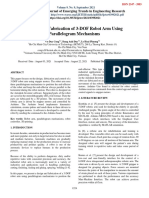




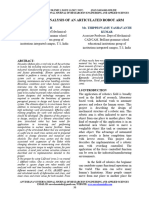














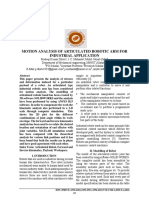


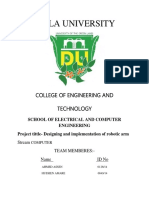





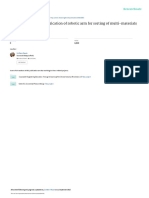














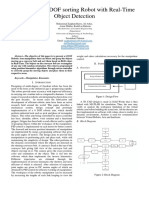



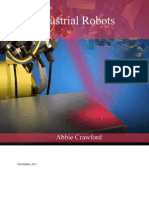




![Practical, Made Easy Guide To Robotics & Automation [Revised Edition]](https://imgv2-1-f.scribdassets.com/img/word_document/253466853/149x198/4281882d40/1709916831?v=1)
































